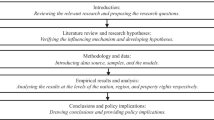Abstract
Taking the “Green Credit Guidelines” issued in 2012 as a quasi-natural experiment and employing the A-share listed enterprises scanning from 2008 to 2020 as the research sample, this study has investigated the impact of green credit policy on total factor productivity at the corporate level in China, with the consideration of the mediating role of debt financing and the moderating role of financial mismatch. The findings are as follows: (1) green credit policy has effectively and directly promoted total factor productivity at the corporate level in China, (2) the mediating role of debt financing is merely supported for the full sample and the state-owned sample, (3) the moderating role of financial mismatch is merely established via codirectionally moderating the negative impact of green credit policy on debt financing for the full sample and the eastern sample, and (4) the non-state-owned enterprises’ dilemma of difficult and expensive debt financing is proved. The conclusions and policy implementations are provided in the last section to highlight the practical and theoretical contributions of this study.



Similar content being viewed by others
Data availability
The data used to support the findings of this study are available from the corresponding author upon request.
References
Cao YW, Zhang YT, Yang L, Li RYM, Crabbe MJC (2021) Green credit policy and maturity mismatch risk in polluting and non-polluting companies. Sustainability 13(7):3615
Feng YC, Wang XH, Du WC, Wu HY, Wang JT (2019) Effects of environmental regulation and FDI on urban innovation in China: a spatial Durbin econometric analysis. J Clean Prod 235:210–224
Feng YC, Wang XH, Liang Z (2021) How does environmental information disclosure affect economic development and haze pollution in Chinese cities? The mediating role of green technology innovation. Sci Total Environ 775:145811
Han ZX, Xu HF, Tu KJ (2019) Research on the effectiveness of green credit policy-based on the empirical study of 19 listed banks in China. In: 2019 3rd International Conference on Data Science and Business Analytics (Icdsba 2019), pp 202–205
Hu GQ, Wang XQ, Wang Y (2021) Can the green credit policy stimulate green innovation in heavily polluting enterprises? Evidence from a quasi-natural experiment in China. Energy Econ 98:105134
Kang H, Jung SY, Lee H (2020) The impact of Green Credit Policy on manufacturers’ efforts to reduce suppliers' pollution. J Clean Prod 248:119271
Karabarbounis M, Macnamara P (2021) Misallocation and financial frictions: the role of long-term financing. Rev Econ Dyn 40:44–63
Levinsohn J, Petrin A (2003) Estimating production functions using inputs to control for unobservables. Rev Econ Stud 70(2):317–341
Ling SX, Han GS, An D, Hunter WC, Li H (2020) The impact of green credit policy on technological innovation of firms in pollution-intensive industries: evidence from China. Sustainability 12(11):4493
Liu JY, Xia Y, Fan Y, Lin SM, Wu J (2017) Assessment of a green credit policy aimed at energy-intensive industries in China based on a financial CGE model. J Clean Prod 163:293–302
Liu XH, Wang EX, Cai DT (2019) Green credit policy, property rights and debt financing: quasi-natural experimental evidence from China. Financ Res Lett 29:129–135
Moll B (2014) Productivity losses from financial frictions: can self-financing undo capital misallocation? Am Econ Rev 104(10):3186–3221
Song ML, Xie QJ, Shen ZY (2021) Impact of green credit on high-efficiency utilization of energy in China considering environmental constraints. Energ Policy 153:112267
Sun JX, Wang F, Yin HT, Zhang B (2019) Money talks: the environmental impact of China’s green credit policy. J Policy Anal Manag 38(3):653–680
Uras BR (2014) Corporate financial structure, misallocation and total factor productivity. J Bank Financ 39:177–191
Wang F, Yang SY, Reisner A, Liu N (2019) Does green credit policy work in China? The correlation between green credit and corporate environmental information disclosure quality. Sustainability 11(3):733
Wang K, Zhao RQ, Chen HR (2018) Optimal credit period and green consumption policies with cash-credit payments under asymmetric information. J Clean Prod 205:706–720
Wang YL, Lei XD, Zhao DX, Long RY, Wu MF (2021) The dual impacts of green credit on economy and environment: evidence from China. Sustainability 13(8):4574
Wen HW, Lee CC, Zhou FX (2021) Green credit policy, credit allocation efficiency and upgrade of energy-intensive enterprises. Energy Econ 94:105099
Wu GL (2018) Capital misallocation in China: financial frictions or policy distortions? J Dev Econ 130:203–223
Xing C, Zhang YM, Wang Y (2020) Do banks value green management in China? The perspective of the green credit policy. Financ Res Lett 35:101601
Xu XK, Li JS (2020) Asymmetric impacts of the policy and development of green credit on the debt financing cost and maturity of different types of enterprises in China. J Clean Prod 264:121574
Zhang B, Yang Y, Bi J (2011) Tracking the implementation of green credit policy in China: top-down perspective and bottom-up reform. J Environ Manag 92(4):1321–1327
Zhou GY, Liu C, Luo SM (2021) Resource allocation effect of green credit policy: based on DID model. Mathematics 9(2):159
Funding
Sponsored by Program for Science and Technology Innovation Talents in Universities of Henan Province (Grant No. 2021-CX-018) and Great Education Science Bidding Project of 14th Five Year Plan in 2022 of Henan Province (Grant No. 2021JKZB05).
Author information
Authors and Affiliations
Contributions
Yanchao Feng: Conceptualization, Methodology, Writing — Original draft; Qiong Shen: Writing — Reviewing and Editing.
Corresponding author
Ethics declarations
Ethics approval and consent to participate
Not applicable.
Consent for publication
Not applicable.
Conflict of interest
The authors declare no competing interests.
Additional information
Responsible Editor: Nicholas Apergis
Publisher’s note
Springer Nature remains neutral with regard to jurisdictional claims in published maps and institutional affiliations.
Rights and permissions
About this article
Cite this article
Feng, Y., Shen, Q. How does green credit policy affect total factor productivity at the corporate level in China: the mediating role of debt financing and the moderating role of financial mismatch. Environ Sci Pollut Res 29, 23237–23248 (2022). https://doi.org/10.1007/s11356-021-17521-3
Received:
Accepted:
Published:
Issue Date:
DOI: https://doi.org/10.1007/s11356-021-17521-3




